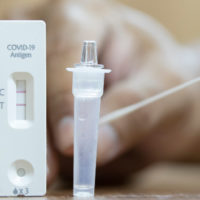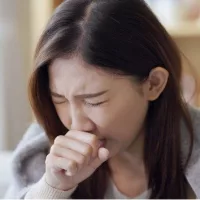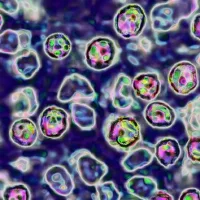
(NEW YORK) — In the early months of the COVID-19 vaccine rollout, breakthrough cases among fully-vaccinated people were a statistical anomaly.
Preliminary clinical trial data offered an optimistic outlook for the months ahead, with many Americans hoping a vaccine would be their ticket to a return to normalcy.
However, last summer, when the highly infectious delta variant became dominant, the number of people experiencing a breakthrough infection began to grow, and those totals only increased with the omicron surge.
Now, with the majority of the country vaccinated, and immunity gradually waning over time, once-scarce breakthrough infections — which the Centers for Disease Control and Prevention (CDC) define as when a fully vaccinated person gets infected with COVID-19 — have become a regular occurrence associated with the pandemic.
As a result, the notion early on that vaccination could be relied upon to prevent all coronavirus infection has been somewhat eroded. But vaccines have remained largely highly protective against severe illness and death.
Experts also say the sheer volume of cases now puts even the vaccinated who are vulnerable in danger and underscores the urgency of people both getting their primary series and boosters.
An ABC News analysis of data collected by the CDC found that the share of breakthrough COVID-19 cases has reached its highest point since the vaccines were introduced, with more cases occurring among the vaccinated in March and April 2022, than among the unvaccinated, partially because of the significant number of people who are now vaccinated.
However, even with overall totals increasing, per capita, unvaccinated Americans still have a greater risk of contracting and dying of COVID-19.
Increasing rates of breakthrough cases
In June 2021, prior to the emergence of the delta variant, breakthrough cases represented only 12% of new cases. By October, as the delta variant continued to dominate, and with an increasing number of people further out from their original vaccine series, breakthrough infections represented about a third of cases.
When the even more transmissible omicron variant emerged in November 2021, the percentage of breakthrough cases began to steadily grow, and by March, breakthrough infections among the vaccinated represented the majority of new cases. Between April 2021 and April 2022, the percentage of breakthrough cases grew from 3% to more than 60%.
With more vulnerable and older Americans further out from their primary series, the rate of breakthrough deaths has also grown. During April 2021, just 8% of deaths were the result of breakthroughs, but by March 2022, that number had increased to more than 41% of the month’s recorded deaths.
Breakthrough cases and deaths among the boosted have also been on the rise, albeit at a slower rate.
In September 2021, less than 1% of COVID-19 of cases and deaths occurred among Americans who had been fully vaccinated and boosted with their first dose. By April 2022, the percentage for cases had increased to more than 52%, while the proportion of deaths had grown to nearly 31%.
Health experts said the increase in breakthrough infections and deaths is expected with more Americans reaching full vaccination status and higher-risk populations getting further away from their initial vaccination series and first booster.
In March 2022, unvaccinated adults were 10 times more likely to die of COVID-19 compared to vaccinated individuals and in April 2.3 times more likely to test positive, according to data from the CDC.
The CDC notes that there are limitations to this data, including a higher prevalence of previous infection among the unvaccinated and unboosted groups, a difficulty in accounting for time since vaccination and waning protection, potential differences in use of at-home tests and prevention behaviors by age and vaccination status.
Yet to receive their first booster
During an interview with CBS News last month, Dr. Anthony Fauci, the White House’s chief medical advisor, acknowledged there has been an increase in the number of vaccinated people who are dying of COVID-19, many of whom are elderly, immunocompromised or have underlying conditions.
“As long as you have vulnerable people in the population, even though the unvaccinated are going to be much more at risk, even vaccinated with underlying conditions and a high degree of susceptibility to severe disease will account for those deaths,” he said.
Unvaccinated Americans also continue to become severely ill and die of the virus, Fauci said. He stressed that a large proportion — about a third of Americans — have not been fully vaccinated, while about half of eligible Americans are still unboosted with their first dose.
According to an ABC News analysis, the vast majority — between 80% and 90% — of the vaccinated Americans who are dying from COVID-19 are people over the age of 65.
Last month, the CDC announced that it is “strengthening” its recommendation for Americans over the age of 12 who are immunocompromised and those over the age of 50 to receive their second booster shot.
“Only 38% of those 50 to 64 and 43% of those 65 and older have received a vaccine dose in the past six months. This leaves about 60% of older Americans without the protection they may need to prevent severe disease, hospitalization, and death,” CDC director Dr. Rochelle Walensky said during a meeting of the agency’s independent advisors in May. “We know immunity wanes over time, and we need to do all we can now to protect those most vulnerable.”
According to CDC data, since second booster doses were authorized in mid-March, a total of 15.4 million Americans have received their second booster. Some 14.7 million of those who have received second boosters are people over the age of 50, and 10.3 million of them are over the age of 65.
“The numbers we are keeping an eye on are the numbers of individuals with breakthrough disease that requires hospitalization, intensive care, or that results in death,” C. Buddy Creech, director of the Vanderbilt Vaccine Research Program and associate professor of pediatric infectious diseases, told ABC News.
“We can anticipate some degree of this among the elderly, those with complicated underlying medical conditions and those that are immunocompromised; however, if we begin to see high numbers among otherwise healthy individuals, it may be a sign that current vaccines aren’t working as well against new variants of concerns,” he added.
The increase in the number of vaccinated people falling ill and dying underlines the urgency for high-risk Americans to get boosted, health experts said.
“For those that are immunocompromised, at high risk for complications, over 50 years of age, or who received their third dose months ago, a fourth dose reduces the likelihood of infection and complications from disease,” Creech said.
‘Vaccines are still working’
The drop in efficacy may come as a shock to some Americans who still envision protection levels of over 90% against symptomatic infection that were initially reported by vaccine makers Pfizer and Moderna in late 2020.
“Vaccine efficacy in clinical trials has been very high, vaccine effectiveness in the real world is always going to be a bit lower. In clinical trials, we typically exclude those that are severely immunocompromised or medically fragile. We also measured vaccine efficacy during a time prior to the emergence of variants and when more risk mitigation strategies were in place,” Creech explained.
However, Creech noted that even with the diminution, “vaccine effectiveness remains quite high,” adding that given the reality that COVID-19 vaccines do not provide complete protection against all disease, he is not surprised that effectiveness for mild or moderate symptoms is lower than what was reported during the trials.
Given delta and omicron’s highly infectious nature, “nearly everyone who has not been vaccinated has now been infected – many people twice, three times, or more,” David Dowdy, an infectious disease epidemiologist at Johns Hopkins Bloomberg School of Public Health, told ABC News.
“That previous infection does provide some protection — but also at the cost of often getting very sick. Over time, more people are also getting vaccinated, so the number of unvaccinated people is getting smaller and smaller. But vaccines are still working,” Dowdy explained.
People should still get vaccinated, experts say
Health experts stressed that even though more breakthrough cases are occurring, Americans should not be dissuaded from getting vaccinated.
“People should absolutely still get vaccinated and boosted if you haven’t already. Vaccines are still highly effective, and for people who have been infected already, vaccines are known to give extra protection,” Dowdy said.
For those who have yet to receive a third dose, “now is the time to get boosted,” Creech said.
Looking ahead to the fall, as the vaccine companies look to develop new and improved shots, Creech said it is important for people to assess when they should get their booster shots.
“There’s hope that they will be even more effective – but in terms of preventing serious illness, the current vaccines are still working very well,” Dowdy added.
For those who have recently received a third dose or who are a few weeks out from having COVID-19 infection, waiting until variant boosters are available might be a more reasonable approach, Creech said.
“We’re not out of the woods yet; however, vaccines have gotten us to a point where our healthcare system can withstand COVID-19 waves without reaching a breaking point,” Creech said.
Copyright © 2022, ABC Audio. All rights reserved.















